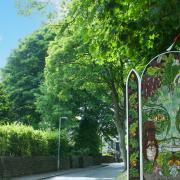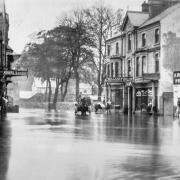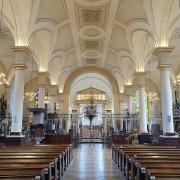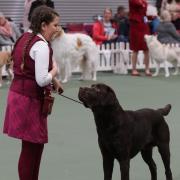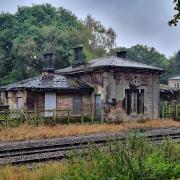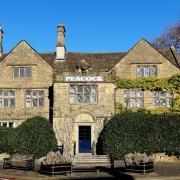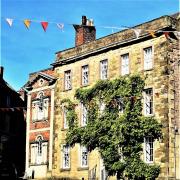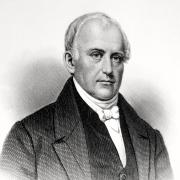Richard Bradley goes in search of Derbyshire's remaining 'crants' - and uncovers a sad South Wingfield-based tale along the way
A ‘crants’, also known as a ‘maiden’s garland’ is a relic from a bygone age, produced following the death of a young unmarried girl of the local community (who theoretically - if adhering to the societal conventions of the time – had remained a virgin).
They are delicate paper hooped garlands which were carried ahead of the coffin at the funeral and subsequently suspended from the roof of the church, sometimes over the pew where the deceased person formerly sat.
Sometimes they were augmented with decorations including paper gloves, paper flowers, painted blown eggshells, ribbons or handkerchiefs.
The word crants is believed to be of Scandinavian origin and the practice is referenced in Shakespeare’s Hamlet when it is said of Ophelia, ‘Yet here she is allow’d her virgin crants, Her maiden strewments and the bringing home Of bell and burial’, suggesting the custom was known in England since at least Tudor times.
These garlands were formerly a widespread sight across Derbyshire, with records of them once having hung in the churches of Beeley, Edlaston, Eyam, Glossop, Hathersage, Heanor, Hope, Fairfield, Tissington, Ashover, Bolsover, West Hallam, Darley Dale, Ilkeston, (where ‘fifty or more’ were said to have hung in the mid-1800s), Crich and South Wingfield (the latter survived into the 20th century, but was destroyed at the behest of church warden William Brighouse, under the grounds that it was ‘nothing but a dust harbourer’).
It is especially regretful that this particular garland has not survived, as it has a local folk tale attached to it.
In the 18th century the landlord of The Peacock at Oakerthorpe was a man named Peter Kendall, who was also a churchwarden at the parish church at South Wingfield.
Kendall had a daughter named Ann who was courted by a young local farmer. Ann subsequently fell pregnant by the farmer but upon discovering this news the ungallant chap decided he wanted nothing more to do with her.
Ann gave birth to a baby daughter, but in view of the social codes of her era she was said to be so affected by the shame and scandal that she died of a broken heart in 1745.
At her funeral a garland was dutifully produced in her memory (despite the fact she clearly wasn’t a virgin) and hung in the church - until it fell foul of Brighouse’s aesthetic sensibilities.
The farmer who failed to accept the consequences of his actions is said to have got his comeuppance one day whilst riding his horse past the church shortly after Ann’s burial.
The church bells suddenly and unexpectedly began to clang out, causing his horse to rear up in surprise, which threw him to the ground, causing death by a broken neck.
When this particular local legend is retold, the farmer’s name is said to be not known – perhaps the moral being that such caddish behaviour in failing to take accountability for actions consigns you to oblivion.
Far be it for me as a folklorist to potentially debunk a good folk tale, but when researching this story I came across a record for an Anne (not Ann, as most tellings of the story have it) Kendall on ancestry.com.
It records that she was born in South Wingfield on November 1 1713, and did indeed die there in 1745 – as did her mother, Mary Kendall née Flint, thus making 1745 a doubly tragic year for Peter - did the scandal also finish off Mary as well?
The record states Anne’s daughter was named Ann Kendall (this time minus the ‘e’) and that she was born in 1745, with the date of her death unknown.
Intriguingly, in Anne’s entry we also have a spouse listed – a Thomas Dodd. Could this be our unchivalrous farmer and if so, contrary to the accepted story, did they marry after all?
Or was Kendall married to Dodd but having an extra-marital affair? Dodd does not have either a birth or death date recorded, giving us no further clues as to his identity.
In A Six Days Ramble over Derbyshire Hills and Dales, in the Year 1858’ (published in Volume 6 of the Derbyshire Archaeological Journal in 1884), Derby-based photographer Richard Keene notes the practice had died out at Hathersage church by that point, but was still upheld elsewhere in the locality.
Whilst travelling on a moorland road leading down to the village he observes, ‘We saw, at a lone house, a garland stretched across the road, with a wreath and a pair of gloves cut in paper suspended from the centre’.
As the custom of making the garlands fell into decline and the family members and friends who remembered the girls they memorialised died off, the surviving crantses began to acquire a status as unlikely souvenirs.
A 1911 article in Folklore journal stated that some from St Giles church at Matlock had been sold to tourists as ‘curiosities’.
That antiquarian magpie Thomas Bateman of Lomberdale Hall near Middleton-by-Wirksworth, an enthusiastic archaeologist frequently to be found digging into prehistoric burial sites in the surrounding Peakland countryside, acquired a pair of garlands from the same church in 1859 whilst the building was being renovated, and placed them in his private museum housed within his stately home.
Happily, St Giles still have a handful of crantses – one of which has been restored thanks to funding from the Churches Council and placed on display in a glass case in the vestry, with a further five kept in archival storage boxes.
On a fieldwork visit to St Giles to document their Blessing of Transport ceremony, church warden Brian Legood kindly retrieved three of the examples which are not normally on display; kept in special acid-free archival boxes in order for me to photograph them.
They were visibly extremely delicate and ephemeral items and their appearance drew interest from regular members of the congregation who had remained after the service, many of whom were unaware of what they were or that the church had them in their possession.
Another Derbyshire church with a handful of surviving crantses is Holy Trinity at Ashford-in-the-Water, where they are displayed hanging from the roof of the church under protective glass domes.
The oldest is thought to have been made as a memorial to Ann Howard, who died aged 21 on April 12 1747.
Another, dating to 1801, remembers Elizabeth Blackwell who was apparently pitched into the River Wye when a carriage overturned and subsequently drowned.
Ashford church also contains a rare recent example of the craft dating to 1995, commemorating the village Sunday School teacher Miss Joy Price who died on October 7 of that year aged 72.
The frame of the garland was constructed by Reverend Clive Thrower, the vicar at Ashford-on-the-Water at the time, and Linda Foster, the wife of the churchwarden, decorated it with a white ribbon.
Other local surviving examples are found at All Saints church, Trusley, where the crants is a memorial to an unnamed member of local landowning family the Cokes, and at the Church of the Holy Cross at Ilam, just across the border into Staffordshire, where two can be found hanging.
Whilst the Derbyshire examples are particularly well-documented and the high density of churches where garlands were formerly to be found demonstrates the custom was practiced with fervour in our county, this is not a custom unique to our area - other surviving crantses are located elsewhere at the churches of Beverley, East Yorkshire; Robin Hood’s Bay, North Yorkshire; Springthorpe, Lincolnshire; and Abbots Ann in Hampshire.












